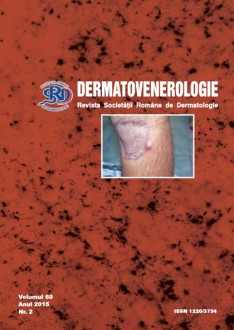Pseudopelade of Brocq is a chronic, slowly progressive, lymphocytic cicatricial alopecia whose exact etiology remains unknown. Described by Brocq in 1905 pseudopelade is characterized by asymptomatic, porcelainwhite or ivory, round or oval, atrophic plaques, with smooth surface without hair follicles, usually noninflammatory, localized on the vertex and parietal areas of the scalp giving the appearance of „en empreinte de pas dans la neige”.
Dermoscopy confirm the absence of hair follicles and perifollicular inflammation and hyperkeratosis. Histopathology is usually nonspecific, in early-stage showing a perifollicular and perivascular ymphocytic infiltrate, and in the late-stage a dermal fibrosis with destruction of the hair follicle. The differential diagnosis is made with alopecia areata and cicatricial alopecia: discoid lupus erythematous, lichen planopilaris, central centrifugal cicatricial alopecia, etc. The treatment is mainly made with topical corticosteroids, intralesional triamcinolone acetonide and in the acute stages of the disease systemic corticosteroids, cyclosporine and mycophenolate mofetil are required.


